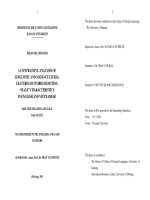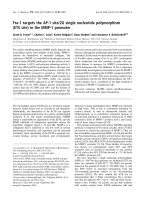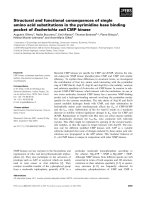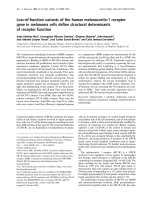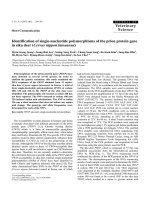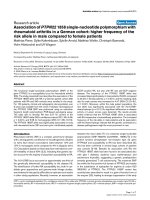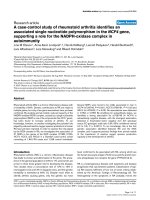Associations of single nucleotide polymorphism rs17782313 in melanocortin 4 receptor gene with anthropometric indices in normal and obesity primary school children in Hanoi
Bạn đang xem bản rút gọn của tài liệu. Xem và tải ngay bản đầy đủ của tài liệu tại đây (216.38 KB, 7 trang )
������������������������������������������������������������������������������������������������������������������������������������������������������������������������������������������������������������������������������������������������������������������������������������������������������������������������������������������������������������������������������������������������������������������������������������������������������������������������������������������������������������������������������������������������������������������������������������������������������������������������������������������������������������������������������������������������������������������������������������������������������������������������������������������������������������������������������������������������������������������������������������������������������������������������������������������������������������������������������������������������������������������������������������������������������������������������������������������������������������������������������������������������������������������������������������������������������������������������������������������������������������������������������������������������������������������������������������������������������������������������������������������������������������������������������������������������������������������������������������������������������������������������������������������������������������������������������������������������������������������������������������������������������������������������������������������������������������������������������������������������������������������������������������������������������������������������������������������������������������������������������������������������������������������������������������������������������������������������������������������������������������������������������������������������������������������������������������������������������������������������������������������������������������������������������������������������������������������������������������������������������������������������������������������������������������������������������������������������������������������������������������������������������������������������������������������������������������������������������������������������������������������������������������������������������������������������������������������������������������������������������������������������������������������������������������������������������������������������������������������������������������������������������������������������������������������������������������������������������������������������������������������������������������������������������������������������������������������������������������������������������������������������������������������������������������������������������������������������������������������������������������������������������������������������������������������������������������������������������������������������������������������������������������������������������������������������������������������������������������������������������������������������������������������������������������������������������������������������������������������������������������������������������������������������������������������������������������������������������������������������������������������������������������������������������������������������������������������������������������������������������������������������������������������������������������������������������������������������������������������������������������������������������������������������������������������������������������������������������������������������������������������������������������������������������������������������������������������������������������������������������������������������������������������������������������������������������������������������������������������������������������������������������������������������������������������������������������������������������������������������������������������������������������������������������������������������������������������������������������������������������������������������������������������������������������������������������������������������������������������������������������������������������������������������������������������������������������������������������������������������������������������������������������������������������������������������������������������������������������������������������������������������������������������������������������������������������������������������������������������������������������������������������������������������������������������������������������������������������������������������������������������������������������������������������������������������������������������������������������������������������������������������������������������������������������������������������������������������������������������������������������������������������������������������������������������������������������������������������������������������������������������������������������������������������������������������������������������������������������������������������������������������������������������������������������������������������������������������������������������������������������������������������������������������������������������������������������������������������������������������������������������������������������������������������������������������������������������������������������������������������������������������������������������������������������������������������������������������������������������������������������������������������������������������������������������������������������������������������������������������������������������������������������������������������������������������������������������������������������������������������������������������������������������������������������������������������������������������������������������������������������������������������������������������������������������������������������������������������������������������������������������������������������������������������������������������������������������������������������������������������������������������������������������������������������������������������������������������������������������������������������������������������������������������������������������������������������������������������������������������������������������������������������������������������������������������������������������������������������������������������������������������������������������������������������������������������������������������������������������������������������������������������������������������������������������������������������������������������������������������������������������������������������������������������������������������������������������������������������������������������������������������������������������������������������������������������������������������������������������������������������������������������������������������������������������������������������������������������������������������������������������������������������������������������������������������������������������������������������������������������������������������������������������������������������������������������������������������������������������������������������������������������������������������������������������������������������������������������������������������������������������������������������������������������������������������������������������������������������������������������������������������������������������������������������������������������������������������������������������������������������������������������������������������������������������������������������������������������������������������������������������������������������������������������������������������������������������������������������������������������������������������������������������������������������������������������������������������������������������������������������������������������������������������������������������������������������������������������������������������������������������������������������������������������������������������������������������������������������������������������������������������������������������������������������������������������������������������������������������������������������������������������������������������������������������������������������������������������������������������������������������������������������������������������������������������������������������������������������������������������������������������������������������������������������������������������������������������������������������������������������������������������������������������������������������������������������������������������������������������������������������������������������������������������������������������������������������������������������������������������������������������������������������������������������������������������������������������������������������������������������������������������������������������������������������������������������������������������������������������������������������������������������������������������������������������������������������������������������������������������������������������������������������������������������������������������������������������������������������������������������������������������������������������������������������������������������������������������������������������������������������������������������������������������������������������������������������������������������������������������������������������������������������������������������������������������������������������������������������������������������������������������������������������������������������������������������������������������������������������������������������������������������������������������������������������������������������������������������������������������������������������������������������������������������������������������������������������������������������������������������������������������������������������������������������������������������������������������������������������������������������������������������������������������������������������������������������������������������������������������������������������������������������������������������������������������������������������������������������������������������������������������������������������������������������������������������������������������������������������������������������������������������������������������������������������������������������������������������������������������������������������������������������������������������������������������������������������������������������������������������������������������������������������������������������������������������������������������������������������������������������������������������������������������������������������������������������������������������������������������������������������������������������������������������������������������������������������������������������������������������������������������������������������������������������������������������������������������������������������������������������������������������������������������������������������������������������������������������������������������������������������������������������������������������������������������������������������������������������������������������������������������������������������������������������������������������������������������������������������������������������������������������������������������������������������������������������������������������������������������������������������������������������������gistic regression
analyses
OR (95% CI)
p
Multivariate logistic regression
analyses
OR* (95% CI)
p*
1
1.0 (0.6 – 1.6)
0.842
1
0.98 (0.59 – 1.63)
0.928
1
1.1 (0.6 – 1.8)
0.6 (0.2 – 1.7)
0.796
0.302
1
1.12 (0.64 – 1.96)
0.546 (0.17 – 1.7)
0.696
0.290
1
1.1 (0.6 – 1.9)
0.751
1
1.14 (0.65 – 1.98)
0.656
1
0.6 (0.2 – 1.7)
0.9 (0.6 – 1.3)
0.779
0.585
1
0.53 (0.17 – 1.68)
0.91 (0.6 – 1.36)
0.281
0.640
* values were adjusted by sex, age, birthweight and living region
4. Discussion
The MC4R transduces its signal by
integrating a satiety signal provided by its
agonist α- melanocyte-stimulating hormone (αMSH) and an orexigenic signal provided by its
antagonist agouti-related protein (AGRP).
These ligands are expressed in the
hypothalamus and are regulated by the
adipocyte-secreted hormone, leptin, to control
food intake and maintain long-term energy
homeostasis [6-8]. Thus, the MC4R gene has
been considered as a genetic factor related to
human obesity [8].
Recently, GWAs demonstrated MC4R to be
one of the genes, which associates with
common obesity [4, 5]. The common
polymorphism rs17782313 has recently been
found to be unequivocally associated with
obesity-related phenotypes in adults and
children in different ethnicity and age groups
[9, 10, 15].
However, the associations of rs17782313
with obesity and anthropometric indices are not
consistent in many populations. For examle, in
Chinese population, despite some studies
showed evidence of the significant association
such as the study by Huang et al [16] in adults;
Lv D et al [17] in children, studies by Tao et al
[18] in adults, Wang et al [19] in children
revealed non-significant association.
In this study, we found that Vietnamese
normal children (6-11 years old) carrying the
CC genotype have highest z score of weight for
age in comparation with ones who carried CT
and TT genotypes (P=0.023). In obese group,
children who carried CC genotype showed
highest data in waist hip ratio while children
whose TT genotype showed the lowest in that
data (p=0.031). This study also did not find the
80
L.T. Tuyet, T.Q. Binh / VNU Journal of Science: Medical and Pharmaceutical Sciences, Vol. 34, No. 2 (2018) 75-81
association between rs17782313 with obesity
among genetic modes of inheritance (p>0.05).
This result may be due to the small sample
size. Our data suggested that the association
between MC4R variant and the change of
weight and the central obesity in Vietnamese
primary school children.
The major strengths of our study are that it
has been the first data of the relation between
SNP rs17782313 near MC4R gene with some
anthropometric indices in Vietnamese people.
However, several limitations need to be
acknowledged. First, the case-control design
did not allow a causal conclusion. Second,
small sample size is also a possible reason
leading to the not significantly association
between rs17782313 and obesity in the cohort.
Next, we were unable to collect information
regarding the food intake and physical activity
levels of the participants, so the relationship
between those two factors toward obesity could
not be evaluated in the study.
Due to the percentage of children who are
overweight and obesity has been increasing in
Vietnam, the study of the relationship between
genetic, environmemtal, gene-environmental
interaction factors and obesity is nescessary.
5. Conclusion
This study showed the significant different
of MC4R rs17782313 polymorphism genotypes
in Z-score of weight for age and weight hip
ratio in primary school children in Vietnam. It
is necessary to extend the scale of the research
and collect more information on both genetic
and environmental factors to identify the geneenvironment interactions to childhood obesity
in Vietnam.
Acknowledgements
We thank colleagues in Hanoi National
University of Education and National Institute
of Nutrition for their kindly help and support.
This study was supported by the grant no.
B2018-YD01 from the Ministry of Education
and Training, and the grant no. 01C-08/052011-2 from Hanoi Department of Science and
Technology, Vietnam.
References
[1] C.H. Andreasen, G. Andersen, Gene environment interactions and obesity - Further
aspects of genome wide association studies,
Nutrition 25(10), (2009), 998.
[2] T. Fall, E. Ingelsson, Genome–wide association
studies of obesity and metabolic syndrome, Mol
Cell Endocrinol, 382(1), (2012), 740.
[3] Y. Lu, R.J. Loos, Obesity genomics: assessing the
transferability of susceptibility loci across diverse
populations, Genome Med, 5(6), (2013), 55.
[4] C. Cyrus, M.H. Ismail, S. Chathoth, et al.,
Analysis
of
the
impact
of
common
polymorphisms of the FTO and MC4R Genes
with the risk of severe obesity in Saudi Arabian
population, Genet Test Mol Biomarkers, 22(3),
(2018), 170.
[5] A.M. de Carvalho, P. Shao, H. Liu et al., The
MC4R genotype is associated with postpartum
weight reduction and glycemic changes among
women with prior gestational diabetes:
longitudinal analysis. Sci Rep 7(1), (2017), 9654.
[6] N. Balthasar, L.T. Dalgaard, C.E. Lee et al.,
Divergence of melanocortin pathways in the
control of food intake and energy expenditure.
Cell, 123(3), (2005), 493.
[7] R.D. Cone, Anatomy and regulation of the
central melanocortin system, Nat Neurosci 8(5),
(2005), 571.
[8] J.F. Davis, D.L. Choi, J.D. Shurdak et al., Central
melanocortins
modulate
mesocorticolimbic
activity and food seeking behavior in the rat.
Physiol Behav 102(5), (2011), 491.
[9] V. Turcot, Y. Lu, H.M. Highland et al., Publisher
Correction: Protein-altering variants associated
with body mass index implicate pathways that
control energy intake and expenditure in obesity.
Nat Genet (2018).
[10] C.M.M. Resende, D.F. Durso, K.B.G. Borges et
al., The polymorphism rs17782313 near MC4R
gene is related with anthropometric changes in
L.T. Tuyet, T.Q, Binh / VNU Journal of Science: Medical and Pharmaceutical Sciences, Vol. 34, No. 2 (2018) 75-81
[11]
[12]
[13]
[14]
women submitted to bariatric surgery over 60
months. Clin Nutr. 5614(17), (2017), 30179-6.
A.L. Hasselbalch, L. Angquist, L. Christiansen et
al., A variant in the fat mass and obesityassociated gene (FTO) and variants near the
melanocortin-4 receptor gene (MC4R) do not
influence dietary intake, J Nutr. 140(4), (2010), 831.
S.F. Grant, J. P. Bradfield, H. Zhang H, et al.,
Investigation of the locus near MC4R with
childhood obesity in Americans of European and
African ancestry. Obesity (Silver Spring). 17(7),
(2009), 1461.
L.T. Tuyet, B.T. Nhung, D.T.A. Dao, et al., The
brain-derived neurotrophic factor val66met
polymorphism, delivery method, birth weight, and
night sleep duration as determinants of obesity in
Vietnamese children of primary school age,
Childhood
Obesity,
(2017),
DOI:
10.1089/chi.2017.0007.
Lê Thị Tuyết, Trần Quang Bình, Bước đầu nghiên
cứu đa hình nucleotide đơn MC4R-rs17782313 ở trẻ
5-6 tuổi Hà Nội bằng phương pháp PCR-RFLP, Tạp
chí Khoa học Đại học Quốc gia Hà Nội, chuyên san
KHTN và Công nghệ, 31 (3), (2015), 57.
81
[15] R.J. Loos, C.M. Lindgren, S. Li, et al., Common
variants near MC4R are associated with fat mass,
weight and risk of obesity, Nat Genet. 40(6),
(2008), 768.
[16] W. Huang, Y. Sun, J. Sun, et al., Combined
effects of FTO rs9939609 and MC4R rs17782313
on obesity and BMI in Chinese Han populations,
Endocrine, 39(1), (2011), 69.
[17] D. Lv, D.D. Zhang, H. Wang, et al., Genetic
variations in SEC16B, MC4R, MAP2K5 and
KCTD15 were associated with childhood obesity
and interacted with dietary behaviors in Chinese
school-age population, Gene, 560(2), 2015, 149.
[18] L. Tao, Z. Zhang, Z. Chen, et al., A Common
variant near the melanocortin 4 receptor is
associated with low-density lipoprotein cholesterol
and total cholesterol in the Chinese Han population,
Mol Biol Rep, 39(6), (2012), 6487.
[19] J. Wang, H. Mei, W. Chen et al., Study of eight
GWAS-identified
common
variants
for
association with obesity-related indices in Chinese
children at puberty, Int J Obes (Lond) 36(4),
(2012), 542.
Mối liên quan giữa đa hình đơn nucleotide rs17782313 của
gen Melanocortin 4 Receptor với một số chỉ số nhân trắc
của trẻ tiểu học bình thường và béo phì ở Hà Nội
Lê Thị Tuyết1, Trần Quang Bình2
1
Khoa Sinh học, Trường Đại học Sư phạm Hà Nội, , 136 Xuân Thủy, Cầu Giấy, Hà Nội, Việt Nam
2
Viện Dinh dưỡng Quốc gia, 48B Tăng Bạt Hổ, Hà Nội, Việt Nam
Tóm tắt: Thụ thể Melanocortin-4 (MC4R) có vai trò trong việc điều chỉnh lượng thức ăn và cân bằng
năng lượng của cơ thể. Một số nghiên cứu trước đây cho thấy SNP rs17782313 của gen MC4R có liên quan
đáng kể với béo phì ở nhiều quần thể người. Tuy vậy, mối liên quan này ở người Việt Nam chưa được mô
tả đầy đủ. Mục đích của nghiên cứu là đánh giá mối liên quan của rs17782313 với một số chỉ số nhân trắc
và béo phì của trẻ tiểu học ở Hà Nội. Nghiên cứu bệnh chứng được tiến hành trên 559 trẻ em từ 6 - 11 tuổi
(278 trẻ béo phì và 281 trẻ bình thường). Tình trạng dinh dưỡng của trẻ được phân loại theo cả hai tiêu
chẩn của IOTF 2000 và WHO 2007. Kết quả cho thấy ở nhóm trẻ bình thường, chỉ số z-score cân nặng theo
tuổi cao nhất ở nhóm trẻ có kiểu gen CC và thấp nhất ở nhóm trẻ có kiểu gen TT (tương ứng là 0,11 và
- 0,38, p=0,023). Ở nhóm trẻ béo phì, tỷ lệ eo hông thấp nhất ở nhóm có kiểu gen TT và cao nhất ở nhóm
có kiểu gen CC (0,93 và 0,97, p=0,031). Kết quả này cho thấy biến thể rs17782313 của gen MC4R nhiều
khả năng ảnh hưởng đến sự tăng khối lượng cơ thể và béo phì trung tâm ở trẻ Việt Nam.
Từ khoá: rs17782313, MC4R, béo phì, chỉ số nhân trắc, trẻ em Việt Nam.



